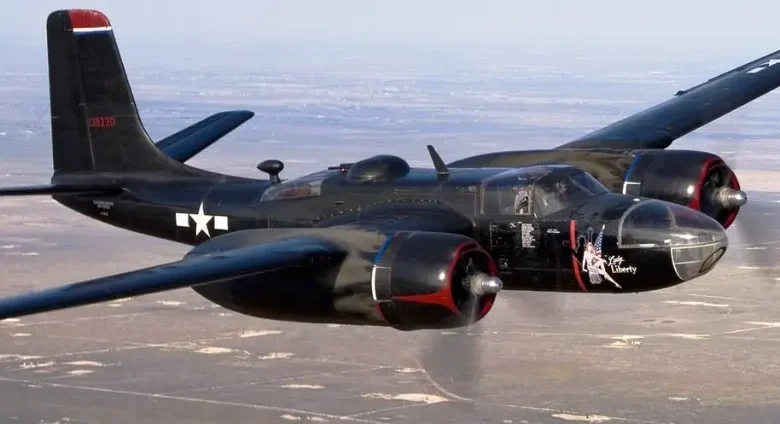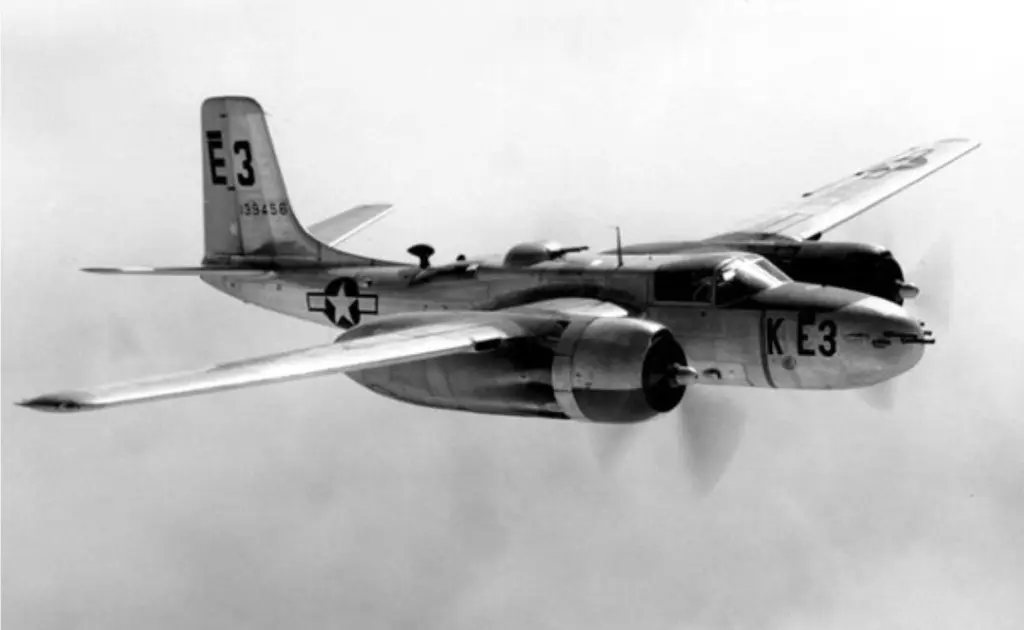Douglas A-26 Invader

The Douglas A-26 Invader (later designated B-26) was a fast, twin-engine light bomber and attack aircraft used by the United States and its allies during World War II, the Korean War, and even into the Vietnam War. Renowned for its speed, versatility, and heavy armament, the A-26 served in bombing, ground attack, and night interdiction roles.
Fact Sheet
| Role | Light Bomber / Attack Aircraft |
|---|---|
| Manufacturer | Douglas Aircraft Company |
| First Flight | July 10, 1942 |
| Service Entry | 1943 |
| Crew | 3–6 (varied by mission and configuration) |
| Number Built | 2,503 |
Specifications (A-26B Model)
| Length | 50 ft 9 in (15.47 m) |
|---|---|
| Wingspan | 70 ft 0 in (21.34 m) |
| Height | 18 ft 6 in (5.64 m) |
| Wing Area | 540 sq ft (50 m²) |
| Empty Weight | 22,850 lb (10,364 kg) |
| Loaded Weight | 27,000 lb (12,247 kg) |
| Max Takeoff Weight | 35,000 lb (15,876 kg) |
| Powerplant | 2 × Pratt & Whitney R-2800-27/71 Double Wasp radial engines (2,000 hp each) |
| Max Speed | 355 mph (571 km/h) |
| Cruise Speed | 230 mph (370 km/h) |
| Range | 1,400 mi (2,300 km) |
| Service Ceiling | 22,000 ft (6,700 m) |
| Rate of Climb | 1,250 ft/min (6.4 m/s) |
Armament & Defensive Equipment
| Guns | Up to 14 × .50 in (12.7 mm) machine guns (8 in nose, 6 in dorsal/ventral turrets and tail) |
|---|---|
| Bomb Load | Up to 6,000 lb (2,700 kg) |
| Aiming Equipment | Norden bombsight or optical gunsight (depending on mission) |
Notable Features
- Fastest American bomber of WWII
- Extremely versatile: bombing, ground attack, night interdiction, and reconnaissance
- Heavy forward-firing armament for ground attack missions
- Served in WWII, Korea, and early Vietnam War
- Used by several air forces worldwide postwar

The Douglas A-26 Invader was an American twin-engine light bomber and ground attack aircraft that served in multiple conflicts across a long and distinguished career. Designed during World War II, its speed, versatility, and heavy armament made it an incredibly effective combat aircraft.
Design and Variants
The A-26 was developed to replace the A-20 Havoc, and its prototype, the XA-26, first flew on July 10, 1942. The aircraft was built in two main production versions, each distinguished by its nose configuration:
- A-26B (Gun Nose): Designed for ground attack and strafing missions, this variant had a solid metal nose that could house up to eight .50 caliber machine guns. The A-26B’s forward-firing armament, which could be augmented by up to six more guns in the wings or in underwing pods, made it a deadly platform for destroying ground targets.
- A-26C (Glass Nose): This model was a medium bomber, featuring a transparent “bomber” nose that housed a Norden bombsight for precision bombing from medium altitudes. This variant was equipped with two fixed .50 caliber machine guns in the fuselage and the same remote-controlled defensive turrets as the ‘B’ model.
The A-26’s modular design allowed the nose sections to be swapped in a matter of hours, enabling a quick change in the aircraft’s mission role. Both versions were equipped with two remote-controlled turrets (one dorsal, one ventral) each housing two .50 caliber machine guns, operated by a single gunner via a periscopic sighting system.
Operational History
The Invader earned the distinction of being the only U.S. bomber to fly missions in three major wars: World War II, the Korean War, and the Vietnam War.
- World War II: The A-26 entered combat in Europe in late 1944, where its speed and heavy armament were highly praised. By the end of the war, A-26s had flown thousands of missions, primarily in ground-attack and interdiction roles.
- Post-War and Korean War: In 1948, the aircraft was redesignated as the B-26 after the retirement of the Martin B-26 Marauder. During the Korean War, B-26s were used extensively for night interdiction missions to attack North Korean supply lines, locomotives, and vehicles.
- Vietnam War: Although officially retired in 1958, the B-26 was recalled for service in the Vietnam War. To address structural fatigue and obsolescence, a highly modified version, the B-26K Counter Invader, was developed. The Counter Invader featured new engines, reinforced wings, and more modern avionics, serving as a ground-attack and night interdiction aircraft until its final retirement in the late 1960s. The U.S. Air Force formally retired the last of its A-26s in 1969. However, some were used by the Colombian Air Force until the early 1980s.



